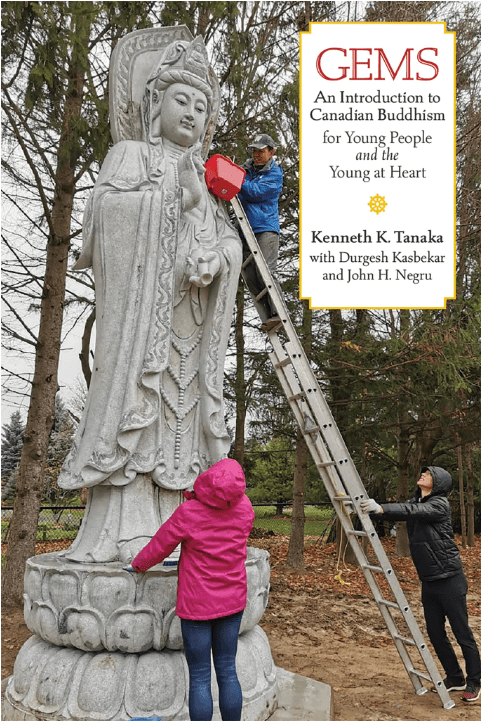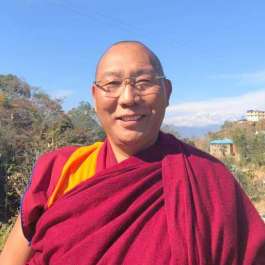Deciding on a title for a book is not always an easy task, but the authors of GEMS: An Introduction to Canadian Buddhism for Young People and the Young at Heart, Kenneth K. Tanaka, with Durgesh Kasbekar and John H. Negru, chose one that functions as both a name and an adjective. The work is truly a gem!
The introduction explains that the title “comes from the Buddhist teaching that sees all living beings as precious gems. Each shining gem is located where strands of interconnection cross one another in the vast web of the universe.” (11) This opening, based on the story of Indra’s Net from the Flower Garland Sutra, sets the tone for an engaging and uplifting read.
As the title promises, youthful and young-at-heart readers are introduced to Buddhism as a global religious tradition that has taken root in Canada. The authors contextualize Buddhism in contemporary Canadian culture in several ways. First and foremost, Tanaka sets the tone for the book with a cartoon that announces Buddhism is “here now” in North America. Tanaka himself is American, but partnered with Canadians Kasbekar and Negru to explore how Buddhism has manifested in the neighbor to the north.
Next, Tanaka confides something very special about Buddhism in North America: “For the first time in the 2,600 years of Buddhist history, virtually all the major Buddhist denominations in the world today are co-existing in many of North America’s largest metropolitan areas,” including Canada’s two largest cities, Toronto and Vancouver. (8) Readers need only look to the “About the Author” sections for proof of this, as Tanaka has personal and scholarly experience in Theravada (Thai) and Mahayana (Chinese and Jodo Shinshu) Buddhisms, Kasbekar is associated with Jodo Shinshu Buddhism, and Negru has experiences from many Buddhist traditions, but identifies predominantly with Tibetan Buddhism.
Tanaka’s introduction to Buddhism for young people, first published in his book Jewels: An Introduction to American Buddhism for Youth, Scouts, and the Young at Heart (2020), is an approachable representation of the Buddhadharma for any reader of English at any age and stage of life. He grounds the offering in the earliest Buddhist teachings, stating that this foundation provides a commonality represented in the teachings and practices of all traditions, yet can never do justice to “the distinct features of the many Buddhist denominations.” (8) Enclosed in the visually appealing pages is an accessible portrayal of the life story of the Buddha, his teachings, heartwarming parables, popular metaphors, and advice for applying Buddhist principles to the challenges of youth.
Tanaka’s tone is amiable and caring. For example, in teaching the Second Noble Truth and the concept of craving for existence, Tanaka offers a joke: Why couldn’t the Buddha vacuum under the sofa? Because he had no attachments (paraphrased from page 139). The jokes in the book are endearingly corny and would be considered “Dad jokes” by today’s younger generations, which is serendipitous, since a recent study found that Dad jokes have the capacity to make us better humans, according to a 2023 study by Marc Hye-Knudsen. Like the Buddha, Tanaka adeptly adjusts tone for distinct audiences.
Co-authors Durgesh Kasbekar and John H. Negru do the ambitious work of contextualizing Buddhism in Canadian culture. It is their chapters that allow GEMS to function as a welcome addition to books about Buddhism in Canada. Currently, readers can look to four scholarly works, an oral history, and a sectarian history for information on Buddhism in the great white north (listed below). To date, GEMS is the only book on Buddhism in Canada to speak directly to Canadian youth.
Kasbekar’s contributions include “Chapter 1: Buddhism in Canada” and “Chapter 5: A Brief History of Buddhism in Canada.” The content of these chapters would appeal to a more mature reader, as Kaskebar has the broad task of orienting Buddhism in Canada both geographically and temporally. Kasbekar uses well-researched demographic data and deftly summarized historical information to situate Buddhism in an ever-changing Canadian cultural landscape. He sets a cordial yet educational tone, using the plural first person “we” to include the reader in a compact rendering of how all types of Buddhism now flourish in Canada.
Negru’s “Chapter 2: Living Buddhist Experience in Canada” and the selection of photos that he has curated are impactful examples of how Buddhism is lived in Canada. He uses the first person singular to speak directly to the young reader and positions himself as a mature Buddhist activist and community developer. He gathers the young reader in with phrases such as “Many thousands of your fellow Canadian citizens worked tirelessly to be good Buddhist ancestors to you and your children yet to be born.” (29) After depicting how Buddhists in Canada work to build and contribute to their communities and the world, Negru passes the torch to his young reader: “I offer you my sincere heartfelt bows of gratitude for your presence here, your energy. I am sure you will discover great truths and do great things in your lifetime. We are all gems together in Indra’s Net.” (40) His personable voice both invites and engenders interdependence.
When reading GEMS, I tried to put myself in the realm of the target audience, especially for the chapters written by Kasbekar and Negru. To do this, I had to shift from my usual reading stance as a religious studies scholar and tap into my role as a parent of two Canadian young adults. Today’s North American youth are growing up in an era of identity politics. They are much more attuned to diversity, equity, and inclusion (DEI) issues than my generation was in its youth. While not central to the book, DEI issues were not overlooked.
For example, in Kasbekar’s Chapter 1, under “Characteristics of Buddhism in Canada” he writes a paragraph that notes the equality of women in Canadian Buddhism, and in Chapter 5 he highlights how the 1988 Multiculturalism Act empowered Buddhist communities to build statues, stupas, and temples, despite strong opposition from local towns and cities. Negru’s chapter on lived Buddhism mentions individual LGBTQI+ Buddhists in a shoutout to influential Canadian Buddhists, and covers suffering caused by racism, such as the internment of Japanese Canadians during World War Two.
Reading GEMS as a parent allowed me to fully appreciate the book for all it offers to young readers. In fact, my only quibble with the book comes from wearing my scholarly glasses, which reveal a small inconsistency in explanations of world religions. Overall, GEMS provides a valuable introduction for youth to Buddhism past, present, and hoped-for future in Canada, and would be well placed on the shelves of public libraries, community centers, sanghas, and temple reading rooms.
References
Kenneth K. Tanaka, Durgesh B. Kasbekar, and John H. Negru. 2022. Gems: An Introduction to Canadian Buddhism for Young People and the Young at Heart. Sumeru Press Incorporated.
Further reading
Harding, John S., Victor Sōgen Hori, and Alexander Soucy. (eds.) 2010. Wild Geese: Buddhism in Canada. Montreal: McGill-Queen’s University Press.
Hori, Victor Sōgen, John S. Harding, and Alexander Duncan Soucy. (eds.) 2014. Flowers on the Rock: Global and Local Buddhisms in Canada. Montreal: McGill-Queen’s University Press.
Parchelo, Innen Ray. 2020. A Path Through Red Maples: The Arrival of Tendai Buddhism in Canada. Ottawa: Sumeru Press Inc.
Peressini, Mauro. 2016. Choosing Buddhism: The Life Stories of Eight Canadians. Ottawa: University of Ottawa Press.
Sugunasiri, Suwanda H. J. 2017. Buddhism in Canada – an Oral History. Access: https://tspace.library.utoronto.ca/handle/1807/78778.
See more
Dad Jokes? That’s the Way Eye Roll… (British Psychological Society)
Related blog posts from BDG Tea House
Is Buddhism Now a Canadian Religion?
Is Buddhism Now a Canadian Religion? Part Two














